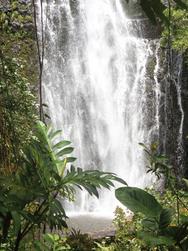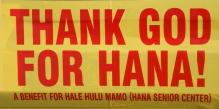A trip to East Maui leads to introspection
by Rob ParsonsAugust 6 , 2009
(As edited by Maui Time. See Unedited Version)
 Photo: Rob Parsons |
 |
 |
Clouds
shrouded the Alenuihaha Channel between Hana and the Big Island as
squalls blew across the choppy ocean waters. Looking down over steeply
sloping pastures, we watched the advancing showers race toward the
shoreline below, where surging waves from Tropical Storm Lana, far to
the south, crashed audibly against the lava rocks, sending cascades of
whitewater into coastal tide pools.
We had no agenda for
our two days in Hana, and no expectations of rain or shine. We were
ready to soak in either—or, as it turned out, both.
Heather and
I left Haiku on Friday afternoon, and encountered little traffic. With
more curves than a beauty pageant competition, the Hana Highway is also
a bit of a misnomer: to the thousands of rental cars that traverse the
scenic, sometimes treacherous road every year, there is little that
resembles the fast-moving turnpikes of the Mainland.
Being "on
assignment" meant that we took our sweet time, stopping at many of the
roadside fruit stands along the way. Smiling Aina, working inside the
refurbished school bus at the bustling Twin Falls fruit and smoothie
stand, was more than happy to pose for a picture. A bit further, the
Huelo Point stop offered a luscious array of fruit, while their
hand-lettered sign also advertised crepes. Each roadside stand has
unique elements to attract travelers. Colorful signs beckon with
sumptuous offerings, ranging from passion fruit to banana bread to
smoked BBQ. My favorite sign: "Honk if you're hungry."
I am
continually amazed by Hana's botanical lushness, cultural richness,
sparkling beaches and unwavering sense of place. Geographic isolation
and high real estate prices are two obvious reasons why the region has
changed little over the years.
Cottages now dot the bluff
below the ballpark, an adjunct of the Hotel Hana, and a few more luxury
homes are tucked into the hillsides. But a golf course proposed years
ago never passed the community's muster, and even ownership changes at
the ranch and hotel don't bring wholesale alterations.
On this
Saturday morning, many donned aloha attire to bid farewell to one of
Hana's matriarch's, Gertrude Boerner, who passed away a month short of
her 99th birthday. Her son, Chuck, has helped spread Hana's tropical
bounty throughout Maui and beyond; his Ono Organic Farms now sets up a
daily stand at the parking lot where the original Hasegawa General
Store stood before it burned down in 1990.
Heather
and I headed away from town, driving through alternating drizzle and
sunshine toward Kipahulu. We huddled under the Ho'onanea Farm stand,
trying to stay dry while Julie cheerfully made us a veggie taco. We
bought a ripe egg fruit, and upon tasting it later, wished we'd bought
the entire box.
After passing the Haleakala National Park
Center, we were met by a smiling local family on horseback who offered
up shakas as we inched by them. We visited the Laulima Farm stand, set
amidst a colorful patchwork of terraced gardens. Inside, a stationary
bike is hooked up to a blender so customers can generate enough
electricity to mix their own smoothies. In the corner stood an enormous
jackfruit, nearly as tall as the four-legged stool beside it. "Yeah,"
said the counter girl, recognizing my astonishment, "that one weighs
more than 50 pounds."
The lush jungle suddenly gave way to the
bare cliff-side, where repairs from the October 2006 earthquake
required a protracted road closure. Now, the wire draping on the pali
resembles a giant hukilau net, as if a Hawaiian demigod hung it there
to dry.
We parked under a hala tree near Alelele bridge, where
the stream waters trickle over smooth river rocks and into the crashing
waves. Pausing to honor the sacredness of the place, we wrapped small
stones in ti leaves and murmured our thanks to the ancestors of this
land.
 |
 |
 |
A nearly hidden path brought us to the foot of Alelele
Falls, water cascading 70 feet down into the pool before us. With
little warning, clouds covered the sun. Winds swept into the valley,
bringing sheets of rain and sending us scampering to the lee side of
the valley wall and into a small grotto overhang. In minutes, the
weather cleared again. We traipsed out, pausing to pick a couple
maunaloa flowers, a sweet pea prized by lei-makers. Heather hung one
pink flower on each of her gold hoop earrings, a delicate reminder of
our adventure-filled hike.
Dinner at Karen Davidson's home above
Mu'olea Point featured a fabulous baked pumpkin from the Hana Fresh
garden stand in front of the Hana Health Center. Satiated, we retired
to bed in her art studio. Colorful paper sculptures of florals,
landscapes and abstracts adorned the walls above, eliciting wildly
imaginative dreams while squalls beat intermittent rhythms on the roof.
Sunday
morning featured a whim of a recipe conceived the night before: pumpkin
pancakes with fresh mangoes! As we ate, Karen asked, "Doesn't it seem
as though the recession is starting to ease up?"
"Not really," I answered, unable to conjure any clear indications of a positive upturn.
Of
the many roadside signs we observed the previous day, one in particular
caught my eye. On a sharp turn between Hana and Kipahulu, a yellow
reflector was affixed to a large mango tree. In the center of the
reflector, a bumper sticker in black gothic letters offered a one-word
mantra: "Change."
Change needn't be scary or imposing. There is
a homeostasis in the unfolding magic; in Hana, the molecules of change
are imbued within the ginger blossoms, moist breezes, smiles of
strangers and even the lava rocks.
And in Heavenly Hana, as sublime and colorful as a ripe mango, change is good.